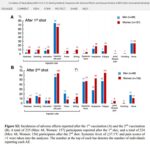Last update and review: August 21, 2021.
A short summary.
This post contains an excerpt from a more detailed article about a noteworthy study from Japan, by Maeda et al., 2021(1). The goal is to underline an important fact that we learn from that study, that is, levels of neutralizing antibodies elicited by vaccination with Pfizer’s mRNA vaccine do NOT correlate with the severity of adverse effects. Those who suffer from adverse effects suffer “for nothing”. More severe adverse effects do NOT mean that “the vaccine is working”.
Important: “no correlation was seen between levels of neutralizing antibodies (“NT50s”) and adverse effects (“AEs”)”.
Maeda et al., 2021 (1):
BNT162b2-elicited immune response has no significant association with adverse effects.
People, who, due to vaccination, have systemic fever of 39 degree Celsius or higher, do NOT have higher antibodies than those who have NO fever. Some with fever have low antibody levels (NT50 titers).



The average half-life of neutralizing activity in the vaccinees was approximately 67.8 days”.
Maeda et al., 2021 (1):
“The average half-life of neutralizing activity in the vaccinees was approximately 67.8 days and the average time length for their serums to lose the detectable neutralizing activity was 198.3 days. “While serums from elite-responders (NT 50 s>1,500-fold: the top 4% among all participants’ 18 NT 50 s) potently to moderately blocked the infectivity of variants of concerns, some serums with 19 moderate NT 50 s failed to block the infectivity of a beta strain.”

Interpretation by Maeda et coworkers, 2021(1).
BNT162b2-elicited immune response has no significant association with adverse effects (AEs).
BNT162b2-efficacy is likely diminished to under detection limit by 6-7 months post-1st shot.
High-level neutralizing antibody-containing serums potently to moderately block the infection of SARS-CoV-2 variants; however, a few moderate-level neutralizing antibody-containing serums failed to do so.
Our interpretation.
If vaccine-elicited immunity memory is short, other protective measures would be needed.
The list of the other protective measures that we recommend.
The measures listed below protect against a large majority of respiratory viruses and other pathogens : Literacy about respiratory viral infections, good nutritional status, Protection measures, hygiene, prophylactic measures, post-exposure prophylaxis, immediate treatment with a generic anti-viral treatment.
Conclusions.
1. Be knowledgeable, keep learning about vaccination and infections. 2. Our current view, as of August 2021, is that only for the most vulnerable individuals, the benefits of the current vaccines may outweigh the associated risks. The vulnerable are defined as those who can’t, for different reasons, take any other protection measure. We do NOT currently recommend ANY of the available COVID-19 vaccines to the generally competent normal people. The risks related to the currently available vaccines are very high. Chimerical adenovirus vector vaccines, mRNA vaccines, and deactivated virus vaccines against SARS-CoV-2 all contain elements that can provoke long-term inflammatory and autoimmune reactions, severe adverse effects, e.g. coagulopathy. Spike-protein of SARS-CoV-2 is not an inert particle. It is highly inflammatory and toxic. Viral mRNA can be integrated into human genome. And though several vaccines were effective in phase-3 trials by protecting against hospitalization, this protection turns out to be short-lived, limited to 2 to 7 months after vaccination. SARS-CoV-2 infection can be avoided rather easily, and it can be treated effectively by literate members of public. Be literate at all times.
Selected references.
1. Kenji Maeda1 , Masayuki Amano 2 , Yukari Uemura 3 , Kiyoto Tsuchiya 4 , Tomoko Matsushima 5 , Kenta Noda5 , Yo s u k e Sh imizu 3 , Asuka Fujiwara 1 , Yuki Takamatsu 1 , Yasuko Ichikawa 6 , Hidehiro Nishimura 6 , Mari Kinoshita 6 , Shota Matsumoto 6 , Hiroyuki Gatanaga 4 , Kazuhisa Yoshimura 7 , Shin-ichi Oka 4 , Ayako Mikami 3 , Wataru Sugiura 3 , Toshiyuki Sato 5 , Tomokazu Yo s h id a 5 , Shinya Shimada 6 , and Hiroaki Mitsuya. Correlates of Neutralizing/SARS-CoV-2-S1-binding Antibody Response with Adverse Effects and Immune Kinetics in BNT162b2-Vaccinated Individuals. A pre-print at available https://www.medrxiv.org/content/10.1101/2021.07.27.21261237v1 Accessed on August 5, 2021.
Maeda and coworkers, 2021: “Both young and older vaccinated individuals with good neutralization response would lose mRNA vaccine protection in 6 to 7 months after the 1st dose.”
Maeda and coworkers, 2021: “Both young and older vaccinated individuals with good neutralization response would lose mRNA vaccine protection in 6 to 7 months after the 1st dose.”









This view seems outright wrong.
mRNA cannot be integrated into the human genome. Unless you happen to be infected with another RNA virus and that RNA viruses reverse transcriptase works on the mRNA strand, and they infect enough cells as to avoid destruction via p53 or mhc based immune reaction. Maybe if the mRNA reached some immunoprivileged tissue ? But if such odds were relevant I’d never stay close to boiling food for fear of insuflating a bit of mRNA.
While the spike protein is not innert. mRNA vaccines do not create the spike protein, they create an albeit more stable tiny protein that should generated the same antibodies (don’t remember the diff but it’s in the dozens vs hundreds)
This protein is not proven to be dangerous in any way beyond hysterical side effects that are barely differentiable from placebo.
A vaccine sized load of tiny fragments of the spike protein is still, almost by definition, less harmful than any viral infection that isn’t stopped after a few days. I assume you’re well aware of the robustness of viruses.
This seems very close to naturalistic quackiness and/or technology fear. Would you be able to justify these claims in regards to mRNA vaccines a bit more broadly?
Which is to say that, even given a low chance of infection (say 5% a year), mRNA vaccines seem like a reasonable choice. But given the increase in spread with more contagious variants the ROI will become better.
Thank you for your comment, George.
There are answers to your questions in the following article:
https://medical-en.nneandersphysiologicalliteracy.com/dna-from-virus-vector-vaccines-always-integrates-into-the-genome-of-the-infected-cell-sars-cov-2-mrna-from-mrna-vaccines-would-also-be-able-to-integrate-human-genome/